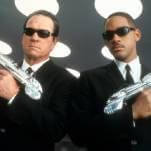It takes a special scientist to make the non-intuitive worlds of quantum physics and relativity accessible to the average reader. Possibly the last author to achieve a popular success at this daunting task was Stephen Hawking, whose A Brief History Of Time sold millions of copies starting in 1988. Like Hawking, Sean Carroll is a theoretical physicist who writes about cosmology—the study of the natural history of the universe and its metaphysical implications. His book features black holes, light cones, wormholes, and contemplation of various scenarios for the universe’s eventual fate (eternal expansion, heat death, Big Crunch, and so on). All these elements are familiar from Hawking’s book and the mesmerizing Errol Morris film that followed. But Carroll has a different aim in mind than helping lay readers catch up on the latest developments in his field, or even arguing for a preferred solution to persistent conceptual problems. From Eternity To Here: The Quest For The Ultimate Theory Of Time might be the best popular-science book ever to attempt a reconciliation of the nature of time itself—an arrow going only one direction, toward the future—with what we know and suspect about the physical properties of existence. Its appeal lies in Carroll’s gift for leading readers through the train of thought that connects black holes, light cones, event horizons, Laplace’s demon (or Maxwell’s), dark energy, and entropy with the question of time.
That question is simply stated. Why does time only go forward? It’s clear that should have something to do with entropy, as defined by the Second Law Of Thermodynamics (and later, more precise formulations taking into account atomic theory and relativity): Closed systems tend to move from lower-entropy states to higher-entropy states. The Second Law defines a “before” and “after” that not only captures our ordinary experience, but also describes experimentally verified phenomena both local and universal. But the equations of theoretical physics don’t require or imply any difference between past and present. They’re time-invariant—or to put it another way, they’re reversible in principle. The experiential fact of irreversibility doesn’t have an explanation in physical law. And once Carroll has pointed out this roadblock to our efforts to understand the universe through physical law, it’s difficult to shake the sense that here is the mystery of all mysteries.
From Eternity To Here doesn’t leave readers in the dark about Carroll’s preferred answer, which has to do with the rapid inflation of the universe at an early stage, the pivotal role of gravity in quantum events for certain configurations of matter/energy and space-time, and the possibility that our universe is part of a multiverse system rather than all there is. But the book isn’t really about the answers, so much as how we know about the problem. With equal parts patience, enthusiasm, and humor, Carroll presents a mini-course on the natural history of cosmology itself: what has been pieced together by evidence, then unraveled by new frames of reference, and the reasons we’re edging closer to answers even though scientific revolutions often seem to take us back to square one. Like all great teachers, he makes his subject irresistible, and makes his students feel smarter.









































